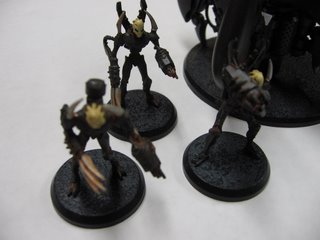Your friendly neighborhood…Games Workshop store?
Yesterday the family went into “the big city” for a day of shopping. One of our required stops was The Vitamin Shoppe and, while we normally go to the one in the West suburbs, this time we found ourselves on the South side. So we pull into the strip mall and what do I see in front of me? There was a big Games Workshop sign. It had been rumored that Milwaukee as getting a Games Workshop store but I had largely forgotten about it. Being so close, I had to stop in and see if I had any sort of reaction ala vampires on holy ground.
The store was about what you would expect: stocked full of Games Workshop products you could buy at full retail. There were six gaming tables (three fantasy, three sci-fi) with two games being played. There were also three folks painting their armies and, in between pestering me, the staff was encouraging the painters. The staff asked if I played Games Workshop games. I said I used to. The staff asked why I quit. I said it was a long story best left unsaid.
Despite the whole Games Workshop “hive mind” thing, the store was about what every brick and mortar store should aspire to be. There was gaming space in view of the customers and there was a place for learning how to paint and staff more than able and willing to help. I didn’t buy anything but that didn’t stop me from thumbing the new codexes to see how things got on since I left the hobby.
Interestingly, in big bold letters where the words "PRINTED IN CHINA". I wondered how many other production Games Workshop had outsourced to China. What about plastics production, or the paint and the glue? I also found it amusing how people online throw stones at prepainted miniatures as somehow supporting third world sweatshops yet think nothing of buying similar products coming from Games Workshop and the sweatshop down the street. At least in the case of prepainted miniatures you are getting a more finished product for the same money instead of letting it go to the corporate fat cats.







